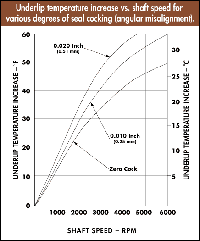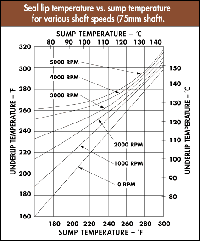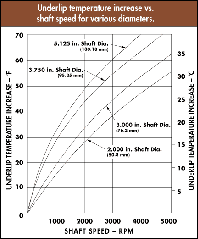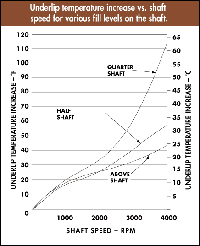|
|

  |
 |
 |
 DYNAMIC TEMPERATURE CONSIDERATIONS DYNAMIC TEMPERATURE CONSIDERATIONS
As the shaft rotates in an oil seal, its lip rides on a thin meniscus of oil. The friction
between the seal lip and shaft generates an under lip temperature in excess of
the oil temperature. When selecting the proper elastomer to achieve long service
life the under lip temperature, rather than sump temperature, should be the
designer’s primary consideration.
Synthetic elastomers are poor thermal conductors which results in the seal lip
absorbing frictional heat without the ability to rapidly dissipate it. The net result
can be under lip temperatures 75°F hotter than the oil temperature. These elevated
temperatures can result in hardening, cracking or blistering of the seal lip, reducing
its ability to function. Under lip temperatures approaching or exceeding an
elastomer’s recommended upper limit will result in dramatically shortened seal life.
Selecting an elastomer with temperature capabilities well above the system
operating temperature is the greatest contributor to prolonged seal life. System
temperatures at or above the upper limit of the elastomer result in a permanent
molecular change to the seal material, shortening its service life. Use of high
performance materials from deVries International such as Viton, Vamac and HNBR
have greatly improved seal performance.
The typical effects of conditions such as RPM, seal cocking, oil level and shaft size
on under lip temperature can be seen in the following charts.
Click on thumbnail image to see full-sized chart.

Underlip temperature increase vs. shaft speed for various degrees of seal cocking (angular misalignment).
|

Seal lip temperature vs. sump temperature for various shaft speeds (75mm shaft).
|

Underlip temperature increase vs. shaft speed for various diameters.
|

Underlip temperature increase vs. shaft speed for various fill levels on the shaft.
|
|
|
|






